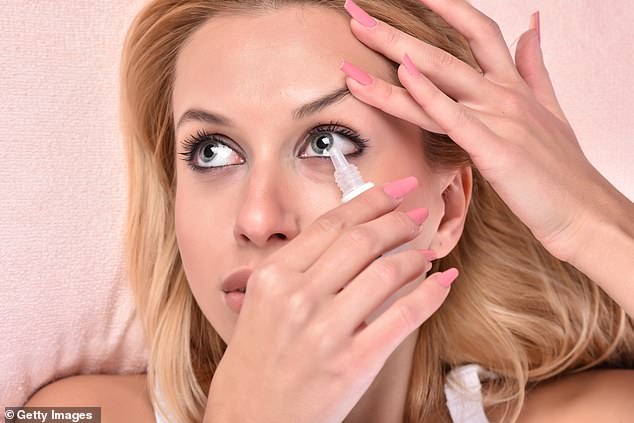EXCLUSIVE: Why you should NEVER buy generic eye drops, according to eye doctors
Eye health specialists have warned against buying store-brand eye drops at drugstores and retailers such as CVS and Target.
Speaking to DailyMail.com, ophthalmologists have claimed that facilities where the generic products are produced are more vulnerable to the infiltration of bacteria, compared to more sanitary factories where branded items are made.
Health officials have discovered four deaths, 14 cases of blindness and 80 eye infections linked to eye drops contaminated with bacteria.
Experts say this is because facilities that make eye drops for multiple stores produce higher revenues but with fewer staff, meaning infection control protocols can be lax.
Dr. Will Flanary, an ophthalmologist in Oregon, advised patients to avoid generic eye drops, such as Target’s recently recalled Up&Up Lubricant Eye Drops, and instead opt for well-known brands such as Refresh, which carry a lower risk of bacterial contamination.
According to market research firm Maximize Market Research, the U.S. eye drop market is worth about $20 billion and is expected to reach $30 billion by 2029.
More than half of generic medicines are produced abroad, in countries such as China and India. According to a 2016 government report, two-thirds of these international factories have never been inspected by the FDA.
The warning comes days after the Food and Drug Administration (FDA) recalled 26 generic eye drop products after a drug-resistant bacteria called pseudomonas aeruginosa — which can cause blindness and, in worst cases, death — was found in the manufacturing facility.
All products deemed at risk had a store brand, including CVS, Rite Aid and Target products.
Generic drops are much cheaper than branded drops, for example CVS’ Health Conservative Free Lubricant Eye Drops cost $15.49, while Refresh Optive Mega-3 Lubricant Drops cost $22.49.
The FDA did not disclose the location of the factory that committed the fault in the most recent recall, but according to the Center for Disease Control and Prevention (CDC), previous outbreaks involving the same bacteria have occurred at an Indian factory.
“It’s always the generic drops that melt people’s eyeballs,” wrote Dr. Will Flanary, an ophthalmologist at EyeHealth North West in Oregon, took to Twitter in response to the FDA recall.
‘Generics are great for things like ibuprofen and paracetamol (a painkiller). For your eyes, you should stick to the well-known brands: Refresh, Systane, Blink, Thera Tears.’

Signs of an eye infection include discharge from the eye, pain or discomfort in the area, redness of the eye or eyelid, feeling like something is in the eye, increased sensitivity to light, and blurred vision
“We have seen nearly 30 over-the-counter generic drops in recent years causing infections, blindness or death,” Dr. Flanary added.
“There were none from the big brand OTC. I stick to these rules for myself and my patients.
“I don’t know which generics to trust, so I’ll stick with the brands.”
Dr. Brian Boxer Wachler, an eye surgeon in California, told DailyMail.com that it is possible that all the recalled products come from the same manufacturing facility, which is common with generic over-the-counter medications.

Dr. Brian Boxer Wachler suggested that recalled generic eye drops could be manufactured in the same factory, while name brand products have their own dedicated factories.
‘Generic medicines often come from one or a limited number of production facilities, and then the different companies put their own labels on them.
“So this could be a facility that supplies the drops to the various companies like CVS, Rite Aid, Target, etc.”
However, brand name OTC eye drops are often produced in a single factory dedicated to the company.
“Look for generics from companies not on the recall list, or look for brand names,” Dr. Wachler said.
The products should be sterile, the FDA warned in its report, meaning they should be free of microorganisms.
But dirty equipment and clothing, as well as poor use of decontamination procedures, lead to the droplets becoming contaminated with bacteria.
According to the Centers for Disease Control and Prevention (CDC), signs of an eye infection by Pseudomonas aeruginosa include discharge from the eye, eye pain or discomfort, redness of the eye or eyelid, feeling as if something is in the eye, increased sensitivity to light, and blurry sight.
People with symptoms of an eye infection should seek immediate medical attention, the FDA said.
